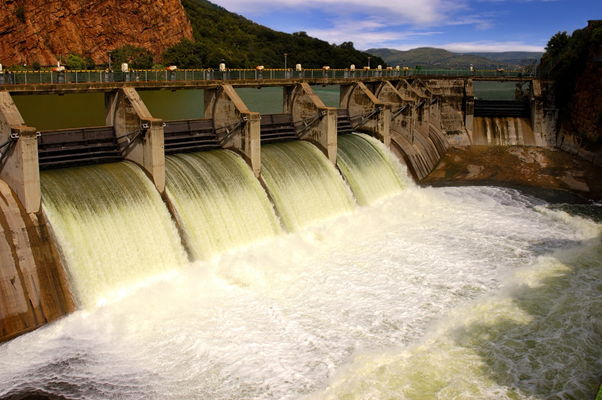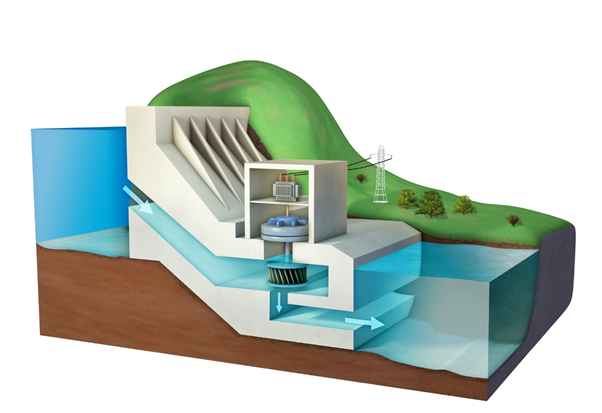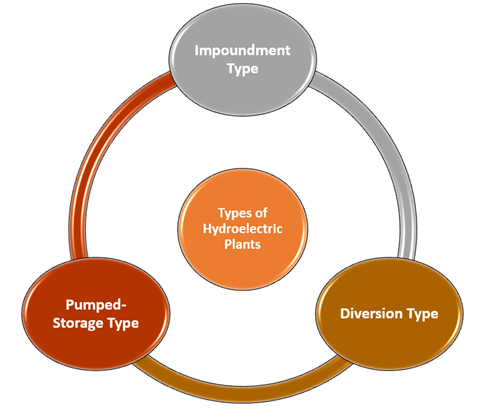What is Hydropower?

Source: © Pretorius | Megapixl.com
Hydropower or hydro-energy is a form of renewable energy that is derived from the kinetic energy of water. Over thousands of years, people in Greece used flowing water to grind wheat into flour. Hydropower is a clean and carbon-free source of energy. It is sometimes also referred to as hydroelectricity. Large scale hydropower plants are constructed to harness energy from flowing water. The energy harnessed by the hydropower plants can be used for domestic as well as industrial purposes. It can also be stored in batteries for later usage.
How does hydropower work?

Source: © Andreus | Megapixl.com
Most hydroelectric power plants some common design features, including a huge reservoir to collect water from seasonal rain or snowpack runoff. The runoff gets collected in lakes, rivers, streams and flows to dams downstream. Another requirement of a hydroelectric power plant is a valve or a gate that can control the water’s output flow. Water stored in the reservoir contains potential energy that is converted into kinetic energy when the water starts flowing through a valve or outlet gate in a downward direction. The flowing water funnels through a dam into a turbine that rotates as the flowing water impacts after striking the turbine's blades. This mechanical turbine is used to generate electricity that can be used for various applications.
What are the different types of Hydroelectric Plants?
There are three major types of hydroelectric plants that are widely available for the generation of electricity. Let us have a look at their major specifications:

Source: Copyright © 2021 Kalkine Media
- Impoundment Type: An impoundment type of hydroelectric power plant is the most basic form that is used to generate electricity. Impoundment type of power plant contains a water reservoir used to store water from runoff through rivers of channels. During high electricity demand season, water is released from the reservoir to pass through the turbine under the influence of gravity. The impact made by the water of turbine blades rotates the turbine and power are generated.
- Diversion Type: Diversion type powerplant is almost similar to Impound type power plant. The primary difference between both of them is the presence of a water reservoir. The Diversion type power plant doesn't incorporate a water reservoir or dam; instead, it uses series of canals to divert water's flow from nearby channels to the turbines. As soon as the water gets access to the turbines, it makes an impact on the blades, and the turbine starts to spin, generating electricity.
- Pumped-Storage Type: The pumped-storage type is slightly different from the other two types of power plants. The water is transported uphill by pumping from a source located at a lower elevation. The energy used for pumping water comes from wind, solar or nuclear energy sources. During high energy time, the stored water is released and fed into the turbines. As the water drifts from a higher to a lower elevation striking the turbine, it rotates and generates electricity.
Summary
- Hydropower is a form of renewable energy that is derived from flowing water. Water strikes the turbine and generates electricity on rotation.
- Water stored in the reservoir contains potential energy that is transformed into kinetic energy when the water flows under the influence of gravity.
- Three types of hydroelectric power plants – Impound, Diversion and Pumped Storage, are used to generate electricity.
Frequently Asked Questions (FAQs):
What are the advantages of hydropower?
There are various advantages of hydropower energy. Let's have a look at the most prominent advantages of hydropower energy.
- Hydropower is a clean energy source as it doesn't emit any greenhouse gas into the atmosphere and used water to generate electricity.
- Hydropower is a domestic source of energy that depends on the water sources present in a particular state. States can fulfil their energy requirements without any dependency on international or national energy sources.
- The water reservoirs created in an Impoundment hydropower plant can be used for other recreational activities, including boating, fishing and water sports.
- Additionally, the water stored in the hydropower plant reservoirs can control flood conditions, irrigation activities, and water supply purposes.
- The flow of water in a hydropower plant can be adjusted as per the electricity requirement. During high demand season flow of water can be increased to produce more electricity and vice-versa.
What are the disadvantages of hydropower?
Having several advantages doesn't mean that hydropower plants don't have any disadvantages. Let's have a look at some of the disadvantages the technology has:
- Higher Investment: The installation of hydropower plants requires a huge initial investment, which limits their construction.
- Limited Location: Hydropower plants can only be installed in limited locations where the supply of water is suitable and sufficient to generate electricity.
- Not entirely carbon-free: The energy generated from the hydropower plants are almost carbon-free, but the construction of dams creates a significant amount of greenhouse emission. The plants present below the dam also produces greenhouse gases on decomposition.
- Flood Risk: Construction of dams at higher elevation create potential flood risk. The dam failures can create huge devastations and create water floods in the nearby areas.
- Susceptible to Droughts: The performance of hydropower plants is dependent on the water supply sources. Since rivers are the major source of water supply, drought conditions can hamper the performance of a hydropower plant.
Where is Hydropower used?
Hydropower energy is the most reliable renewable energy source in the world. China is the leading hydropower producer in the world. The US, India, Canada, Brazil and Russia are also significant producers of hydropower. Approximately 71 per cent of the world's total renewable energy comes from hydropower.
Where is the world’s biggest hydropower plant?
The world’s biggest hydropower plant, the Three Gorges Dam, is located in China. The plant is located on the Yangtze River. The dam has a production capacity of 22,500 megawatts. The plant is 7,660 feet long and 607 feet tall.
 UK
UK AU
AU CA
CA US
US NZ
NZ IND
IND
 Please wait processing your request...
Please wait processing your request...